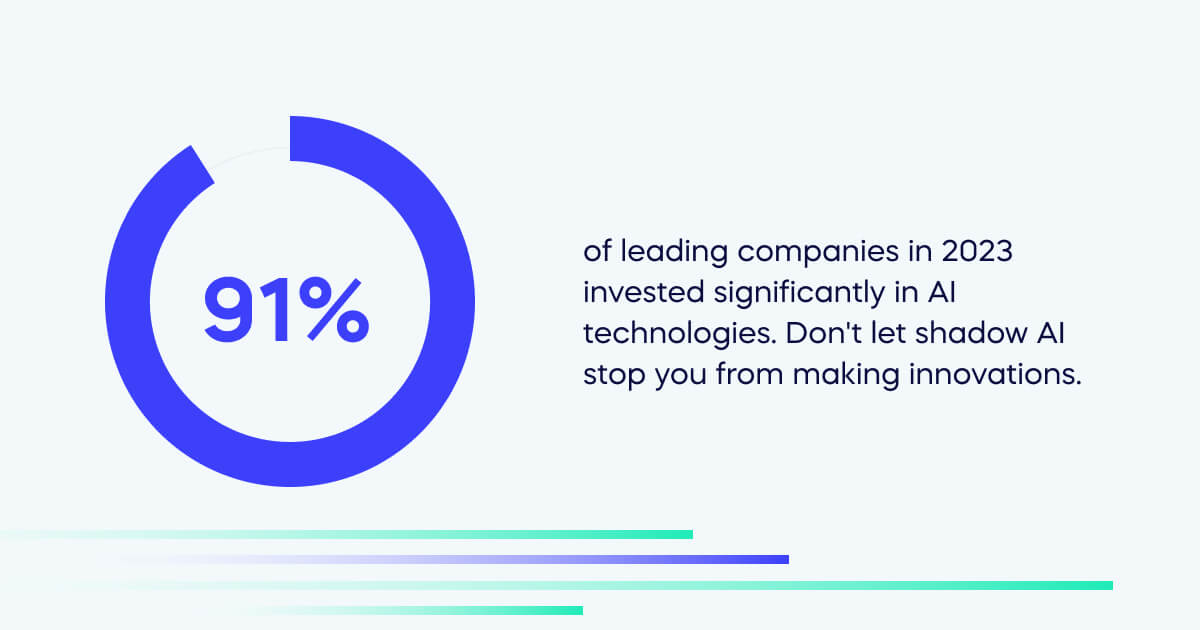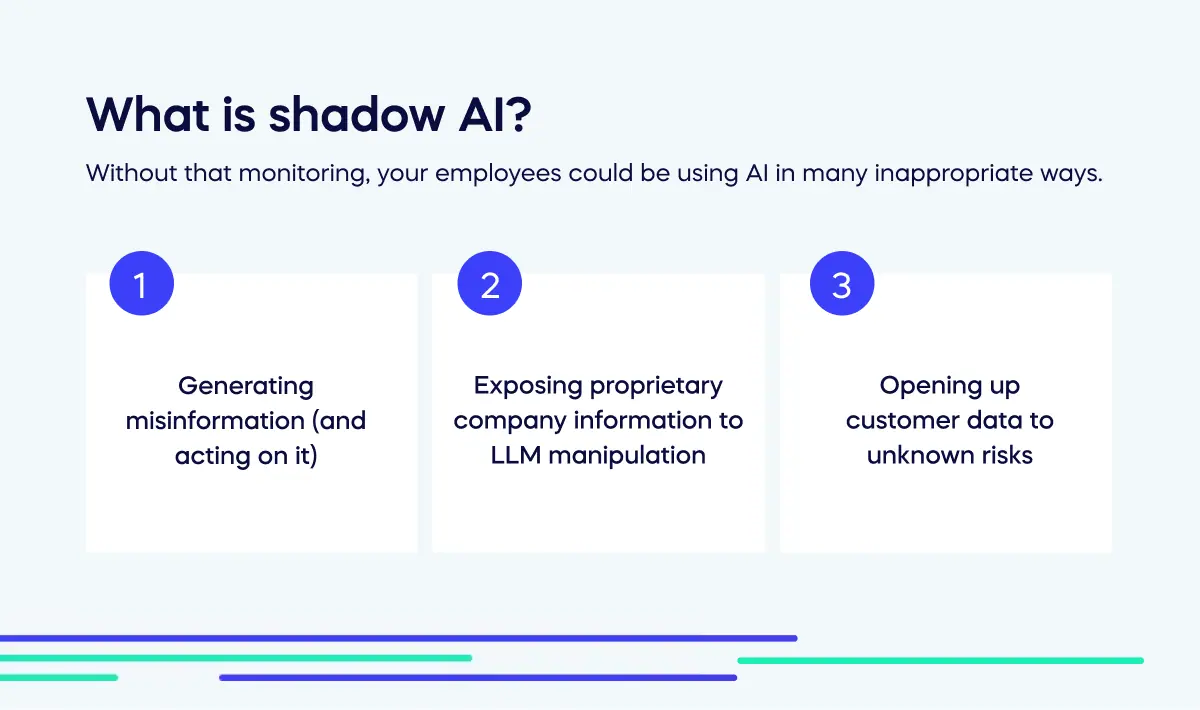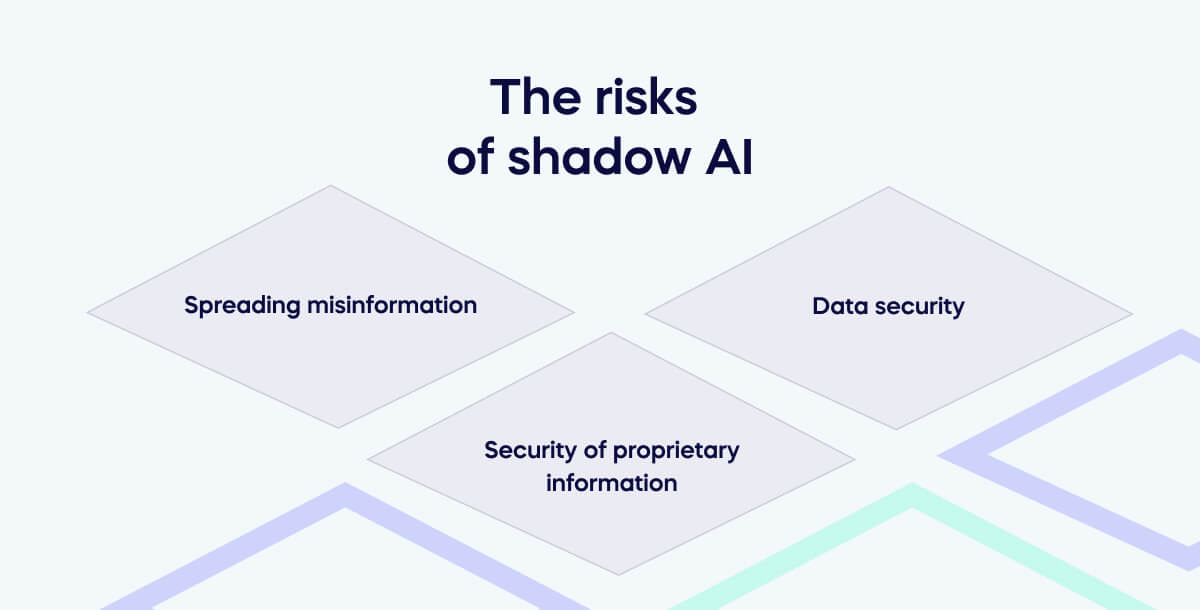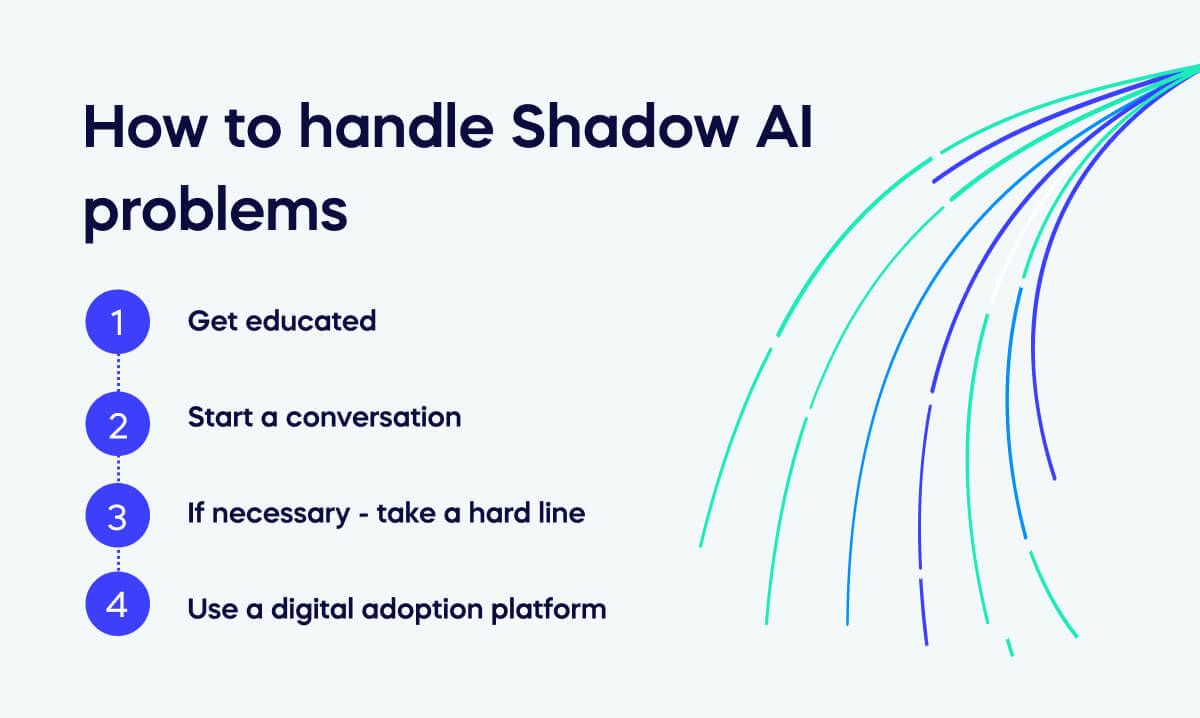Shadow AI is a term used to describe artificial intelligence (AI) applications and tools implemented and used without the explicit knowledge or control of an organization’s IT department.
These AI solutions can range from chatbots, such as ChatGPT and Bard, to more advanced AI technologies that employees may adopt for their own use beyond official corporate oversight.
The concept of Shadow AI has evolved from the phenomenon of ‘Shadow IT,’ which refers to the use of IT systems and solutions not managed or approved by the corporate IT department. However, Shadow AI poses potentially greater risks due to the inherent complexity and unpredictability of AI systems.
While Shadow AI can drive innovation and efficiency by allowing users to quickly meet their needs, it also introduces significant risks. These include data privacy issues, non-compliance with regulatory standards, and potential exposure to cyber threats. Therefore, understanding and managing Shadow AI is becoming increasingly important in today’s digital environment.
Shadow AI represents the hidden, uncontrolled frontier of AI usage within organizations, bringing both opportunities for individual productivity and challenges for corporate governance and risk management.
This article will help make sense of the problems created by the surreptitious use of shadow AI in the workplace. It will:
- Clearly define Shadow AI
- Explain the problems it causes
- Examine some of the important solutions for shadow AI.
In 2023, 91% of leading companies invested significantly in AI technologies. Don’t let shadow AI stop you from making innovations. There is nothing to worry about with the right strategy and hardware in place.
If you’re in that group, a strategy for shadow AI is essential.

What is shadow AI?
Shadow AI refers to artificial intelligence systems operating beyond the visibility or control of those responsible for overseeing them. This can occur when AI applications are developed or used without being officially sanctioned or monitored by an organization’s IT department.
Shadow AI poses risks, including data privacy violations, regulatory non-compliance, and potential security breaches. It underscores the need for robust AI governance within organizations and the ability to audit and monitor AI activities.
When IT signs off on particular technology, you can trust in simple measures like end-to-end encryption; reliable storage facilities; and the ability for IT leadership to easily monitor exactly what’s happening and where.
Without that monitoring, your employees could be using AI in many inappropriate ways.
- Generating misinformation (and acting on it)
- Exposing proprietary company information to LLM manipulation
- Opening up customer data to unknown risks.

Although a lot of the landscape of AI is still unknown, the problems of Shadow AI are real. In May 2023, for example, Samsung temporarily banned using any unauthorized AI applications after an internal data leak.
The most prominent aspects of Shadow AI are part of wider AI security issues. AI Security has been recognized as a key concern for the sector since at least 2019, when Gartner identified security as an important strategic trend. The AI landscape has changed since then. However, privacy risks are more relevant in this rapidly-changing environment than ever.
By the way. Although “shadow IT” and “rogue IT” are the same thing, “shadow AI” and “rogue AI” are very different. “Rogue AI” refers to the dangers of careless use of AI: this is a real problem, but we won’t discuss it in this article.
The risks of shadow AI
The use of Shadow AI presents various risks, such as compromising data privacy, failing to meet regulatory requirements, and exposing vulnerabilities to potential security breaches. These risks highlight the critical importance of implementing robust AI governance frameworks within organizations.
However, there’s a ton about AI that the folks in marketing, finance, or sales don’t know anything about. They won’t think about risk assessments or rigorous testing. So, the risks are huge if their local innovations are suddenly embedded as normal company practices. In this section, we’ll give a brief overview of the key dangers.

Spreading misinformation
For general non-critical information, detecting misinformation quickly and easily is possible. But what about the most recent updates in local legislation? Or market trends over the past decade?
Regrettably, generative AI has gained notoriety for fabricating information that holds no relevance to the real world. When such misinformation is conveyed to customers, it not only exposes companies to the risk of appearing foolish but also poses a more severe threat by potentially influencing flawed decision-making. Whether it pertains to strategic planning or operational processes, the ramifications of flawed information from generative AI can be detrimental.
You can see the risks of financial losses, compliance failures, and missed opportunities. If employees are using shadow AI applications without any sign-off, they are potentially creating major problems for leadership.
Data security
Employing generative AI raises significant data privacy risks.
For the user, inputting information into an AI chat panel isn’t a big deal. However, handing over that information is not secure. If the LLM is using that data for further training, you’re handing private information over for the bot to learn.
In the future, those models may that personal information from training data. The AI may inadvertently replicate identifiable details, exposing individuals without their consent.
It’s still too early to say all the different ways that shadow AI applications might compromise data privacy. Major data breaches affect millions of people. Statista reports that generative AI may be one more loophole that data can leak through.
Security of proprietary information
Similarly, it’s not just sensitive data that AI may expose.
For example, if you’ve used a careful series of prompts to generate code for highly specific tasks – congratulations, ChatGPT now knows a shortcut to the solution! That’s bad news is you’ve got any competition.
Likewise, if you’ve used the AI tool to check computer code or summarize a unique strategy, it’s obvious that AI is not a secure conversation: only regulated AI activities can be trusted.

How to handle Shadow AI problems
In an ideal world, when your staff discovers amazing applications for generative AI, your company will quickly move the “shadow AI” use case into its portfolio of SaaS asset management.
It’s a nice dream. But to make that happen, you’ve got to take some proactive steps. This section reviews some basics: you must get informed, start a conversation, and take a stance. As a bonus, we will also introduce the role of Digital Adoption Platforms as one of the critical technologies to fight shadow AI problems.
Get educated
Leadership teams must stay well-informed to effectively guide intelligent decision-making on shadow AI.
Understanding the evolving landscape of AI technologies, associated risks, and potential benefits equips leaders to establish clear policies, allocate resources wisely, and promote responsible AI practices.
Informed leadership ensures that AI initiatives align with organizational goals, ethical standards, and compliance requirements, fostering a secure and forward-thinking approach to AI adoption while mitigating potential pitfalls.
Start a conversation
Conversations and workshops with staff at all levels facilitate sound decision-making regarding shadow AI. These interactions provide a platform for sharing insights, concerns, and best practices, enabling a comprehensive understanding of the organization’s AI needs and challenges.
By involving employees in these discussions, organizations can identify potential instances of shadow AI, educate staff about risks, and foster a collaborative environment where ideas for AI projects can be vetted, approved, and developed with proper oversight. This inclusive approach enhances transparency, encourages responsible AI adoption, and empowers employees to make informed decisions that align with the organization’s strategic objectives.
If necessary – take a hard line
In smaller companies, a soft approach might help resolve shadow AI. As long as staff are open about using AI solutions, leadership staff can learn how to leverage this technology better.
However, medium- to large-size organizations will need to give staff less wiggle room. The CIO of Avnet, Max Chan, takes a very cautious approach to AI: “If someone wants to try it, they have to submit a request, and we have to review it, and we will work with them to build a minimum viable product.”
Although this creates more paperwork, a cautious approach is more likely to produce reliable and trustworthy results in the long run.
Use a digital adoption platform
For years, digital adoption platforms have been helping businesses to make workplace technology run efficiently. DAPs have adapted to the many challenges of recent years: and the major players in the field are always focused on the complex future of their services.
It is reassuring to know that DAPs like WalkMe are already responding to the challenges of shadow AI. With WalkMe discovery, leaders can quickly track how their employees use major AI applications. WalkME gives IT leaders the insights they need to make effective decisions about AI.
Once you have the insights you need, WalkMe can then put walkthroughs, workflows, and contextual help to ensure employees use it correctly.
With a DAP, you can let employees be curious about IT – while keeping company data safe and protected.

Let’s Talk About The Future of Shadow AI
There are many specific use cases for Generative AI across every industry. And although the future is uncertain for this technology, most companies will want to deploy AI solutions to efficiently improve company performance.
Like any technological development for business, change managers know that they must plan effectively for digital transformation and security together. Generative AI can easily slip through the net.
And as we stand amid a lot of hype around AI, it’s no surprise that shadow AI poses such a risk. People are getting “trained” in many ways that won’t help organizational performance.
But as we have seen, the solutions are there. Plan appropriately, and you can so long as you plan appropriately.

